2020 Ford Shelby GT500 Review
 View more photos
View more photos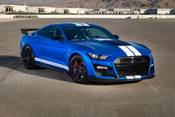 View more photos
View more photos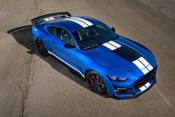 View more photos
View more photos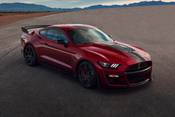 View more photos
View more photos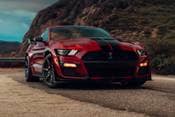 View more photos
View more photosWhat's new
- The GT500 returns after a six-year absence
- Supercharged V8 good for 760 horsepower
- Available carbon-fiber wheels
- Part of the sixth Mustang generation introduced for 2015
Edmunds Tested: Mustang GT500 vs. Charger Hellcat vs. Camaro ZL1
When you have three of the most powerful and highest-performing muscle cars the world has ever seen, you do the ultimate muscle car test.
That's exactly what the Edmunds team did in December when we had a 2019 Chevrolet Camaro ZL1 1LE, a 2019 Dodge Challenger Hellcat Redeye Widebody and a 2020 Ford Mustang Shelby GT500 Carbon Fiber Track Pack. Total horsepower? 2,207.

The team spent two weeks testing and evaluating these three, just like we do with every vehicle that enters our garage. We logged performance figures at our private test facility, and hosts Carlos Lago, Kurt Niebuhr and Elana Scherr lived with each car, using them for errands and Instagram postings.
To film the drag race and comparison videos, we spent two days at a larger facility since there are precious few places to safely and legally run three cars side by side up to 130 mph.
The specs and notes from our test team follow below.

Technical specifications and performance data
| 2019 Chevrolet | 2019 Dodge Challenger Hellcat Redeye Widebody | 2020 Ford Mustang Shelby GT500 Carbon Fiber Track Pack |
Price, base; as-tested (includes destination and gas-guzzler tax) | $64,695; $75,485 | $79,440; $89,595 | $73,995; $94,265 |
Configuration | Front-engine, RWD | Front-engine, RWD | Front-engine, RWD |
Engine | Supercharged 6.2-liter V8 | Supercharged 6.2-liter V8 | Supercharged 5.2-liter V8 |
Output | 650 hp @ 6,500 rpm, 650 lb-ft of torque @ 3,600 rpm | 797 hp @ 6,300 rpm, 707 lb-ft of torque @ 4,500 rpm | 760 hp @ 7,300 rpm, 625 lb-ft of torque @ 5,000 rpm |
Redline | 6,500 rpm | 6,400 rpm | 7,500 rpm |
Fuel economy, combined (city/highway) | 16 mpg (13/21) | 16 mpg (13/22) | 14 mpg (12/18) |
Transmission, final drive, differential type | 10-speed automatic, 2.85:1, electronic limited-slip | 8-speed automatic, 3.09:1, asymmetric limited-slip | 7-speed dual-clutch automatic, 3.73:1, Torsen limited-slip |
Front suspension | MacPherson strut, Multimatic DSSV coilover shocks, adj. camber plates, adj. strut mounts, adj. height, stabilizer bar | Independent SLA, electronically adj. Bilstein coilover shocks, stabilizer bar | MacPherson strut, electronically adj. MagneRide shocks, adj. strut mounts, stabilizer bar |
Rear suspension | Independent five-link, Multimatic DSSV shocks, adj. stabilizer bar | Independent five-link, electronically adj. Bilstein shocks, stabilizer bar | Independent integral-link, electronically adj. MagneRide shocks, stabilizer bar |
Brakes: f;r | 15.4-in vented rotors w/ six-piston calipers; 14.4-in vented rotors w/ four-piston calipers | 15.4-in vented and slotted rotors w/ six-piston calipers; 13.8-in vented and slotted rotors with four-piston calipers | 16.5-in vented rotors w/ six-piston calipers; 14.6-in vented rotors w/ four-piston calipers |
Wheels: f; r, construction | 19 x 11-in; 19 x 12-in, forged aluminum | 20 x 11-in, forged aluminum | 20 x 11-in; 20 x 11.5-in, carbon fiber |
Tires: f; r | Goodyear Eagle F1 Supercar 3R305/30R19; 325/30R19 | Pirelli P Zero 305/35R20 | Michelin Pilot Sport Cup 2 |
Wheelbase | 110.7 in | 116.2 in | 107.1 in |
L x W x H | 190.2 x 74.7 x 52.4 in | 197.5 x 78.3 x 57.5 in | 189.5 x 76.6 x 53.7 in |
Weight (f%/r%) | 3,892 lbs (54.8/45.2) | 4,527 lbs (56.9/43.1) | 4,058 lbs (56.6/43.4) |
lb/hp | 6.0 | 5.7 | 5.3 |
0-45 mph | 2.8 sec | 3.1 sec | 2.8 sec |
0-60 mph | 3.9 sec | 4.2 sec | 3.8 sec |
0-60 mph (w/ 1-ft rollout) | 3.5 sec | 3.9 sec | 3.5 sec |
0-75 mph | 5.1 sec | 5.3 sec | 4.8 sec |
Quarter-mile | 11.6 sec @ 122.4 mph | 11.7 sec @ 127.0 mph | 11.3 sec @ 130.7 mph |
Braking, 60-0 mph | 102 ft | 102 ft | 98 ft |
200-ft skidpad, g (avg) | 1.21 | 1.00 | 1.17 |
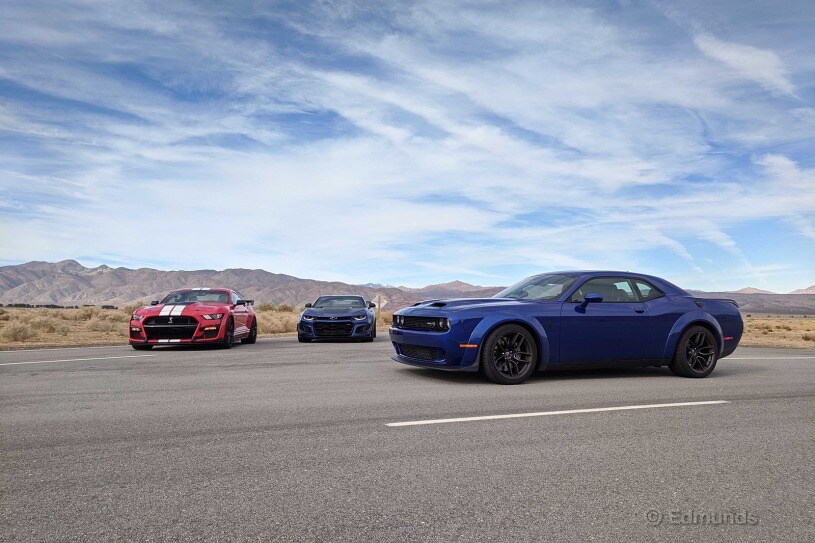
Testing notes
Test date: December 9, 2019
2019 Chevrolet Camaro ZL1 1LE
Driver: Kurt Niebuhr
Weather conditions
Temp: 65.8 degrees
Barometer: 30.0 inches Hg
Humidity: 55.6%
Wind speed: 5.4 mph
Wind direction: Tail and cross
Acceleration
Weird as it is to have a 10-speed automatic paired to a 650-hp V8, it makes a case for itself when you're really on it. Revs are nearly always at peak power and there's no real pause and following torque/power spike to upset the car and spin the tires. Key-up is fairly ferocious and traction, though ample, is limited by the cold-ish tires. Very little wheelspin to get the 1LE sideways and it gets points for stability when something like a Hellcat would be trying to jump the fence. Shifts are quick and smooth, but not snappy like a dual-clutch. That's not a complaint, just an observation.
Launch control is through Performance Traction Management, though with the lack of traction, I went with Sport 1. You'd need to get these tires really hot on a grippy surface to use Race, and we didn't have anything approaching that level of grip. Launch control almost bogs it down off the line and you wonder if the run is blown before the Camaro just explodes down the straight. Nearly holy hell, but it's almost too quiet to be this fast. It almost takes away from the thrill to not hear more of the blower, exhaust or both.

Braking
Good brakes in this car, but the tires need temp to have any grip. Cooldown was shortened just to keep the rubber warm-ish. No brake dive, just stopping power time after time. Great feel, great stability. Proof that Chevy can build a car that stops when it cares enough. Could do this all day.
Handling
Tires need heat. Sound familiar? Cooling temps and a setting sun meant most runs needed two to six warm-up laps before it felt like it wouldn't swap ends. With these tires, the 1LE is damn near dangerous when it's chilly outside. But once up to temp, damn! The aero bits might not be working at these speeds, but it's fun to imagine they're doing something.
Takes some recalibration to get the car up to the right speed to start a skidpad run. Tires are near silent no matter what's happening, so you've gotta pay really close attention to know what's happening. ESC seems really good right off the bat. Still, 1.16 g (avg)? That's insane. Peak runs had Performance Traction Management in Sport 2, but all the way off was very close. Again, cooler temps and lack of constant temps limited the numbers. Fairly amazing, even if the car is a single purpose hot-lapper.
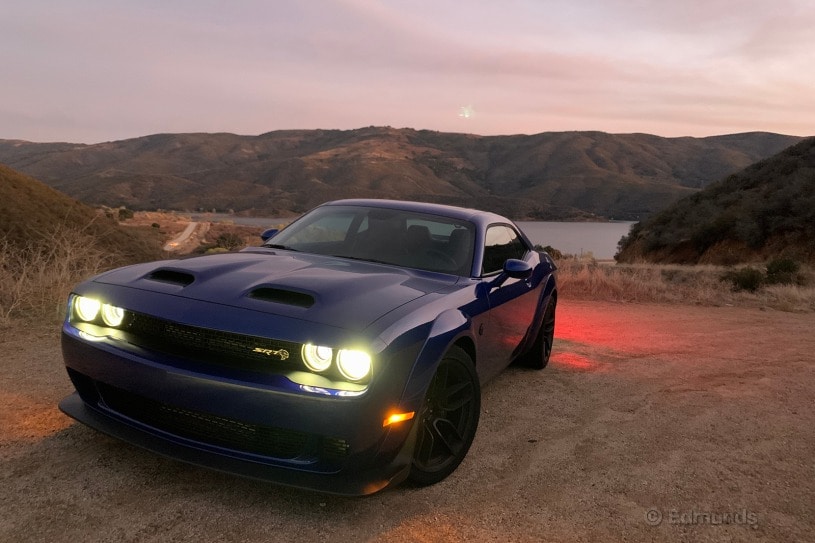
2019 Dodge Challenger Hellcat Redeye Widebody
Driver: Jonathan Elfalan
Weather conditions
Temp: 65.3 degrees
Barometer: 30.0 inches Hg
Humidity: 56.7%
Wind speed: 4.9 mph
Wind direction: Tail and cross
Acceleration
Echoing Kurt's sentiments here the first time we tested. Not enough grip to even use a fraction of the power off the line. Launch control has a selectable engine speed, but it's not a very smart system. It's quicker to do things manually. Our best run came using the same approach as last time, starting in second gear and just easing into the power until you get right below the wheelspin. I kept street traction on, and it seemed to net a similar result that Kurt with it off. Acceleration is otherwordly when you actually have traction.
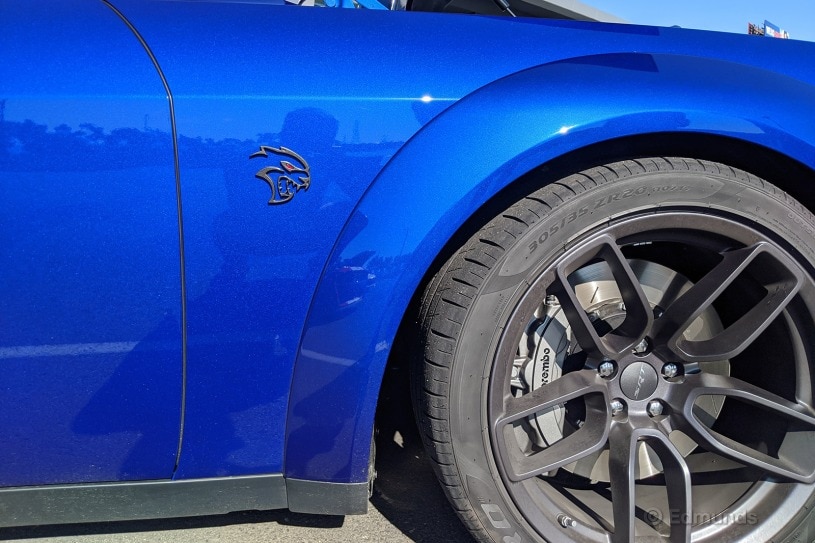
Braking
Feels like I needed quite a bit of pedal pressure to reach the ABS threshold braking. Also experienced some wooden pedal moments after a few accel runs, which Kurt did not experience. Now I'm thinking the pads might be slightly glazed? Otherwise the tires do an admirable job of bringing this heavyweight down to a stop, at least from 60 mph. 102 feet? That's impressive. And consistent.
Handling
Yeah, this is still a big, heavy muscle car not originally intended for curves. It steers and goes pretty well and has a pretty nice amount of grip, but you can feel that once you break it loose at some speed you're gonna be sliding for a while. Steering feels a bit slow and light on feedback, but it's enough to sense when the front end goes away. It pushes at the limit as long as you are patient with the throttle. The Track mode suspension setting is pretty stiff even around this skidpad area. It works well for the skidpad itself, but any of the bumps around the track make themselves known. Obviously not the right choice for a track-day weekend.
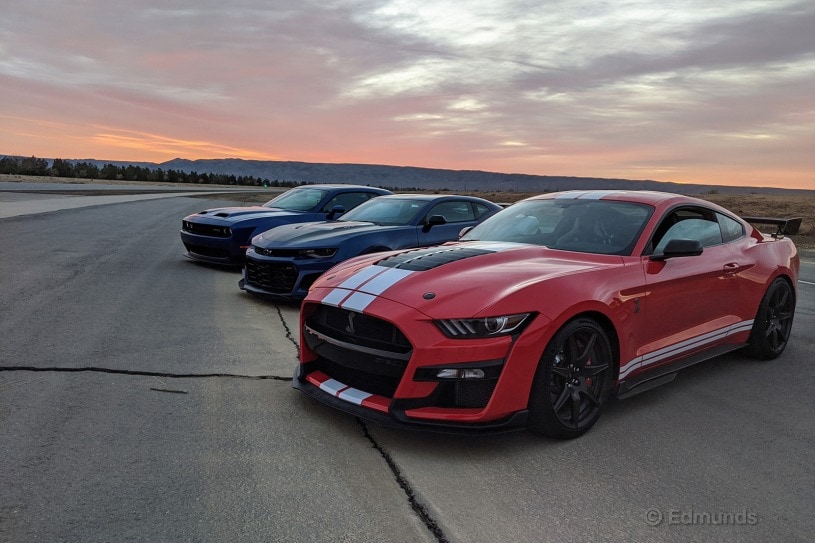
2020 Ford Mustang Shelby GT500 Carbon Fiber Track Pack
Driver: Kurt Niebuhr
Weather conditions
Temp: 67.1 degrees
Barometer: 30.0 inches Hg
Humidity: 54.3%
Wind speed: 3.3 mph
Wind direction: Tail and cross
Acceleration
Ferocious is really the only word you can use. Key-up accel was very fast, even with the standard ESC setting and no real heat in the tires. Wheelspin was managed with a bit of heavy hand, but it never shut the car down — you just felt it fighting until the car finally had some traction. The Redeye, for example, lets too much wheelspin happen before clamping down too far before letting it spin up again before finally just giving up. The GT500 seems to understand things a bit better.
The 1-2 shift spins the tires (ESC flashes but stays low-key) and the 2-3 shift chirps them. That's over 70 mph. The bottom end on this thing is impressive. With "only" 5.2 liters, there's a lot of power under 3,000 rpm. Thanks, giant blower! Above 5,000 rpm this thing just ignites. Thanks again, giant blower! Acceleration is unbelievable. It pulls very, very hard to 7,500 rpm before doing it again in the next gear unabated. 127 mph trap in key-up settings. 131.6 in the quickest. Madness. Launch control lets you tailor the launch rpm, but even down to 1,200 rpm (the lowest allowed), there was still a fair bit of spin/intervention.
Shifts are a bit firmer, but they don't feel engineered that way — it's simply a lot of power cutting out and then coming back in. With ESC off, you need to stay sharp as the car will spin its wheels at nearly 100 mph if it's cooler or the surface is a tad dirty. Super duper impressed. Monstrous power. 5 stars. Would go full throttle again.

Braking
I knew it had a sub-100-footer in it. Sport Cup 2s really help, but the GT500 is remarkably stable and really shows just how good the Mustang platform has become. Like other Mustangs, the pedal is firm and the brakes come in high, not far into the pedal stroke. But unlike other Mustangs, about 90% of the braking power happens immediately, making for some abrupt stops at higher speeds when you're simply trying to scrub off a bit of speed or brake at 50%. Besides that, pedal feel is excellent and you have all the confidence you need to stop from 60. Repeatedly.
Handling
No doubt this car had a pretty aggressive alignment (the camber plates looked to be maxed-out), but these are still fairly ridiculous numbers from a Mustang. Turn-in is crisp, but still a little numb … but the steering lets you get right down to business. There's decent feel for something so big and heavy — and with so much tire — and there's a LOT of stick. Power can be metered out with some subtlety — in third gear. Body roll is minimal. Recaros do the trick.
The Sport Cup 2s talk just a little bit as you get close to the limit where the GT500 tends to understeer away the grip. Feels pretty safe for 760 HORSEPOWER. The thing absolutely monsters the handling loop. The front tires start to fade on this short track before the end of three laps but the brakes stay with you. Spinning off into the sticks only requires turning off traction control. ESC is best left on, really. Stupid fast.
2020 Ford Shelby GT500 First Drive
We Let 760 HP Rip on the Racetrack and Drag Strip
The Ford Mustang Shelby GT500 has never been a stranger to headlines.
Since the model's reintroduction in 2007, the GT500 has continually reset expectations for power and performance. Consider the 2013 model, which boasted 662 horsepower and a 200-mph top speed. Those numbers were unheard of for muscle cars of the time.
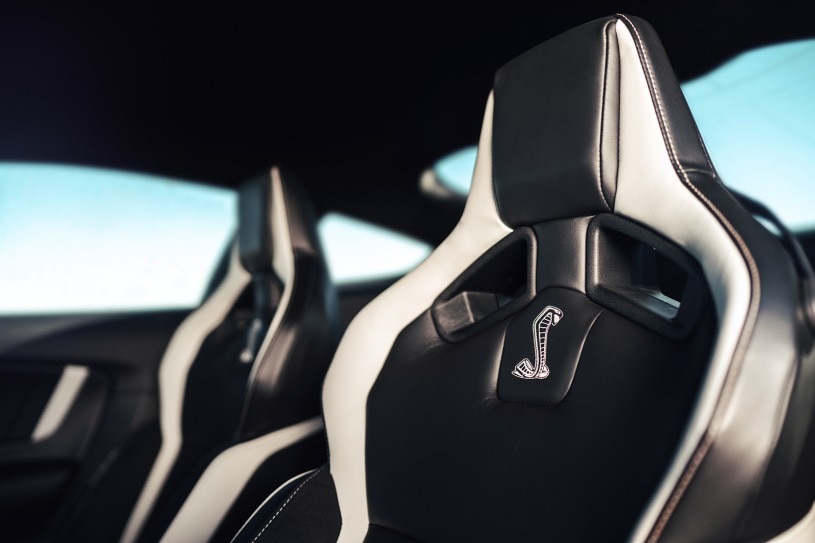
The 2020 Ford Mustang Shelby GT500 continues its regularly scheduled power climb with a supercharged 5.2-liter V8 that makes 760 hp on 93 octane. But there are two new curious attributes to its arsenal: a lower 180-mph top speed and a standard seven-speed dual-clutch automatic transmission.
Absurd top speeds are decidedly less useful than transmissions, but both changes point to how Ford wants this new model to perform. Instead of being just a hot rod with a massive engine and a lofty top speed, the new GT500 seeks to be capable on a racetrack too.
What's it like on the road?
We primarily drove a GT500 equipped with the optional Carbon Fiber Track package. Its lower ride height, 20-inch carbon-fiber wheels, front splitter extensions, and adjustable wing all scream "racetrack-use only." But unless you've got a tow vehicle and trailer, you still have to drive to the track. That's what we did.
Settling into the bucket seats reveals manual adjustments and no lumbar. The side bolsters are snug but not overly tight, and we didn't feel much discomfort during approximately 100 miles of road driving. The sole downside is that, to exit, you have to slide the seat back to make enough room between the bolsters and the steering wheel. We can live with that.
Poke the start button and the V8 lets out a loud rasp before settling to a burly idle. The rotary shifter is an odd sight in a Mustang, but the GT500's new dual-clutch automatic is so well-behaved that you'll quickly get used to it. Twist the knob to Drive and roll onto the gas pedal and the GT500 moves off smoothly and promptly.

The GT500 reaches highway speeds — and highway-plus-plus speeds — effortlessly. The numbers change in the digital speedometer with a brutal matter-of-factness. Aside from the blaring soundtrack from the exhaust, the GT500 is utterly stable so the only real drama is the damage potential to your driver's license. The Michelin Pilot Sport Cup 2 front tires (part of the Carbon Fiber Track package) are very eager to follow every groove in the road, but otherwise the GT500 takes easily to freeway traffic. Even the adaptive MagneRide shock absorbers keep the ride tolerable.
Like the Mustang GT, the GT500 has what looks like toggle switches at the bottom of its center console that you can use to select different drive modes and change the volume of the exhaust. Unfortunately, the switches only move one way. That's fine if, for example, you make the one click from Normal to Sport mode. But if you want to get back to Normal from Sport, you have to click through Track, Drag Strip and Slippery first. It's a small yet silly annoyance.
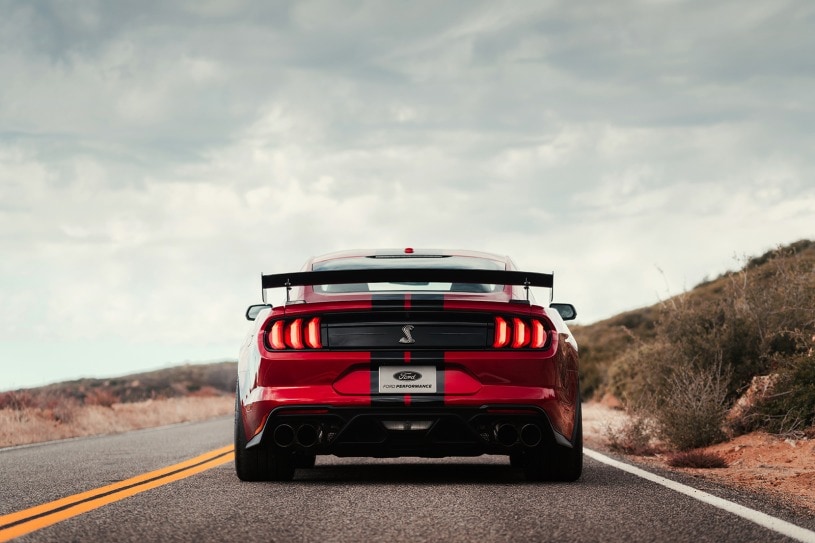
How does it do at the drag strip?
Did somebody say burnout? Along with the Drag Strip mode, which prepares the transmission for quick upshifts, the GT500 also has launch control and a line lock, a drag-racing feature that holds down the front brakes but leaves the rears free for burnouts.
While rear tire destruction is simple, activating the line lock feature is a fussy process that requires multiple brake applications and button presses. And in order to roll away from the burnout — like you would if you were doing it the old-fashioned way — you must disable traction control, which in turn disables launch control. Flipping the switch to reengage traction control is easy, assuming you remember to do so. Under the watchful eye of onlookers and the pressure of competition, it might be easy to forget.
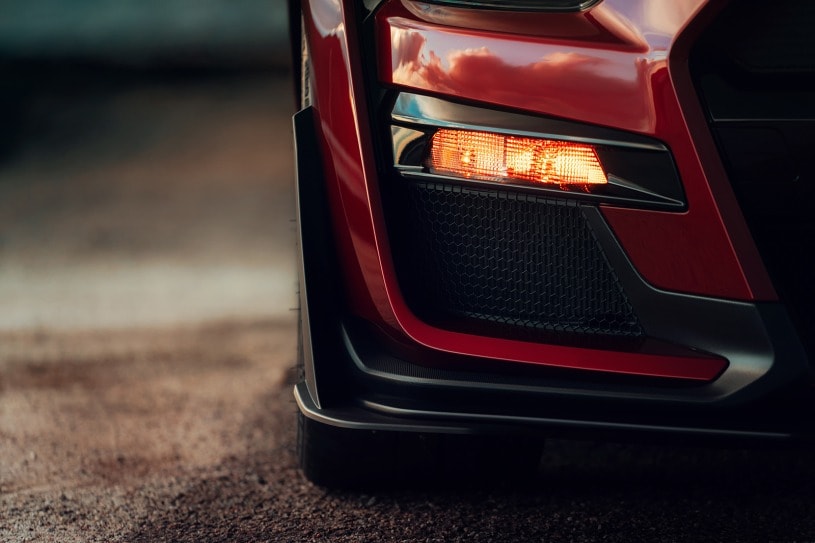
Launch control itself is as straightforward as mashing the brake and gas pedals. The engine shoots to a preselected rpm that you can adjust between runs. Once there, the exhaust's rhythmic thump-thump-thump sounds like a low tom drum.
There is a slight delay from when you release the brake pedal to when the GT500 starts moving forward. Though launch control is consistent, this delay hurts your reaction time when you're facing timing lights, be they a Christmas tree at a drag strip or a stoplight.
We have no such complaints about what happens after that delay. The GT500 simply piles on the speed. We ran a few mid-11-second passes and are convinced that Ford's 3.3-second 0-60 mph and 10.7-second quarter-mile claims are reachable with a prepared surface and better conditions.
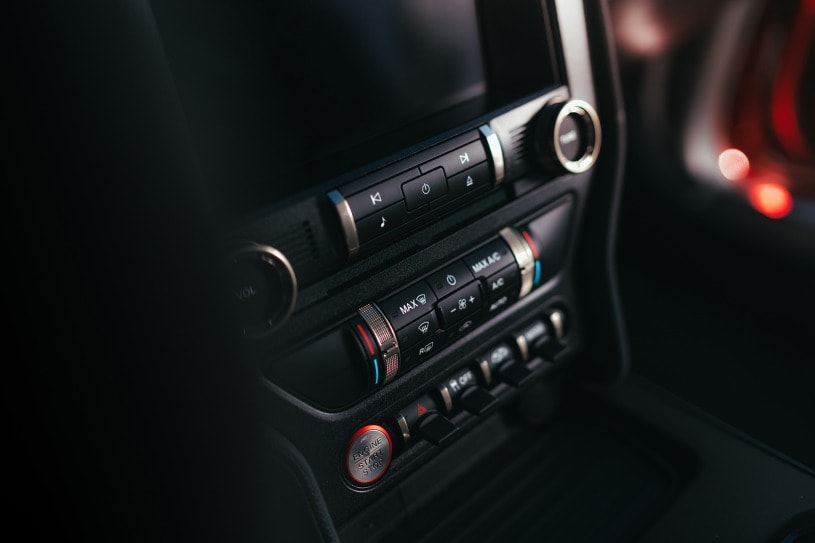
What about the racetrack?
What makes the GT500 tricky to drive fast isn't the power so much as it is realizing how hard you can push it. The Michelin Pilot Sport Cup 2 tires provide unflappable stick and permit higher corner-entry speeds than you expect. The GT500 eliminates speed just as easily and effortlessly as it puts it on, too. The preposterously sized brake rotors (16.5-inch front and 14.6-inch rear) are overshadowed by the size of the gargantuan six-piston front calipers, among the largest Brembo makes for production cars.
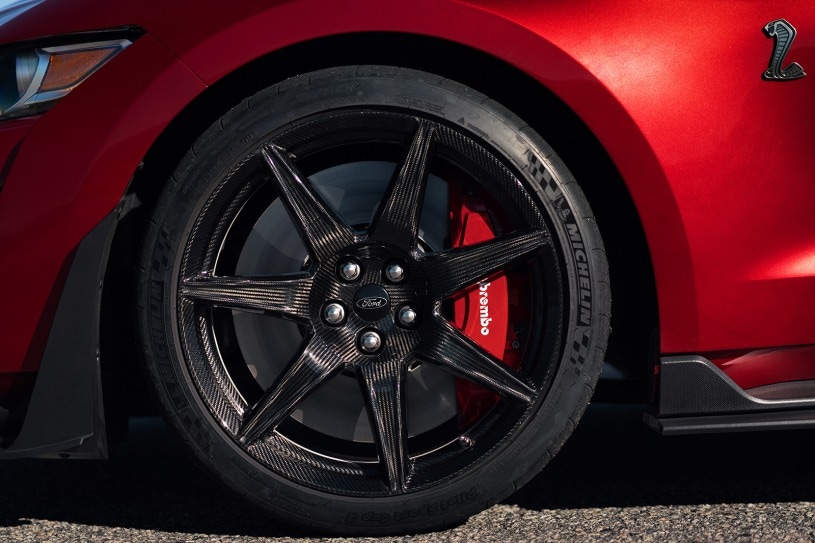
The GT500 welcomes trail braking, which is a technique that involves keeping slight brake pressure on while turning into a corner. Doing so allows additional adjustments to your line before you're midcorner, helping establish a better exit. That, in turn, means you can let the 760 hp loose for the next straight sooner. After every corner, you'll realize you could've applied more gas pedal.
The transmission is ideally matched for the V8's power. During our drive, we left it in Track mode and never felt the need to grab a manual downshift — it always has the right gear because it knows where the engine makes the most power. It also adjusts shift speed in consideration of cornering.
Still want to shift yourself? No problem. Pulling on a shift paddle results in impressively quick upshifts and downshifts. The paddles also offer two neat tricks: Holding the downshift paddle sends you to the lowest possible gear, while pulling both paddles gives you a temporary neutral so you can rev the engine whenever needed. That's important stuff for tunnels and onlookers.
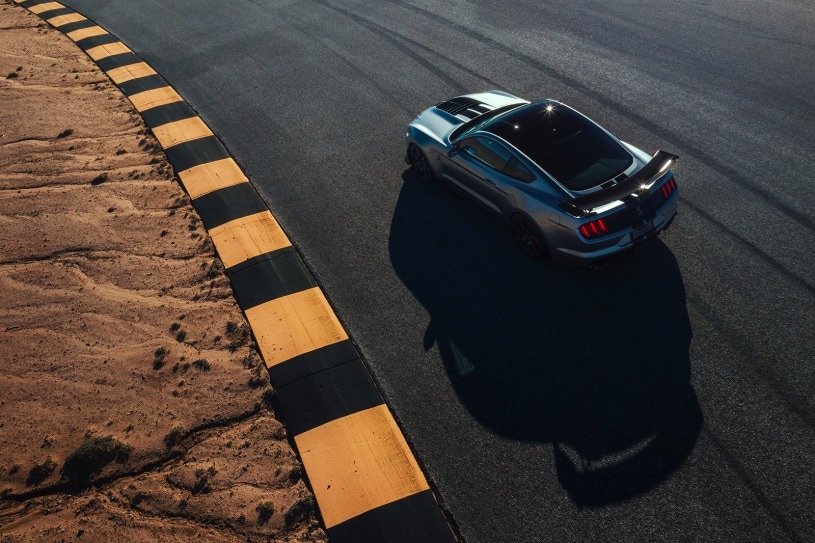
What is its closest competition?
The BMW M4 and Mercedes-AMG C 63 sure have better-looking interiors, but in comparison to the GT500 they vanish in plumes of tire smoke when it comes to performance-per-dollar. How many dollars? The GT500 starts at $73,995 (including destination).
The Carbon Fiber Track package has a stout price tag of $18,500. Navigation, blind-spot monitoring and power seat adjustments come in a separate $3,000 Technology package. Want real paint stripes instead of the more common add-on graphical stripes? That'll be another $10,000. Now you're looking at a Mustang that costs more than $100,000. But even without the stripes, the GT500 ends up being more expensive than top-end, track-ready versions of the Chevrolet Camaro and Dodge Challenger.
Which one is the best of the three? A comparison is inevitable. We pity the tires.
2020 Ford Shelby GT500 First Look
The Shelby GT500 Is Back With Bite and Worth the Wait
That whooshing sound you hear is the sigh of relief from Mustang fans who have been waiting for Ford to show the new Shelby GT500. It's been half a decade since Ford has had a GT500 Mustang in its stable, but Ford says the 2020 Shelby GT500 is going to be worth the wait. There are still secrets to be revealed, but based on what we know so far, this snake is going to have some bite.
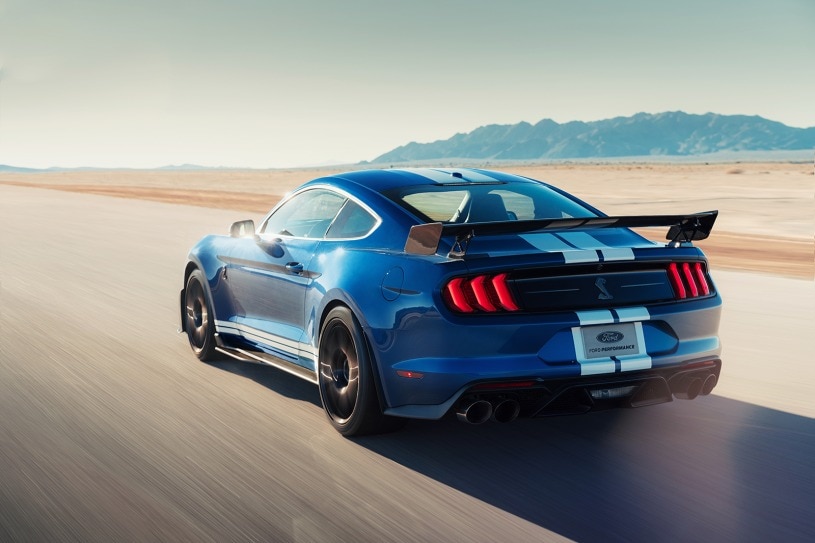
Big Boost
Normally we'd begin a First Look with how the car looks, but the Shelby GT500 has always been a performance car with a focus on big power numbers. So let's start off with the go-fast stuff. Under the GT500-specific bulging hood will be a supercharged 5.2-liter V8. It uses the same aluminum block as the GT350 version. But instead of going with the exotic flat-plane crank, the GT500's V8 will employ a traditional crossplane crank. The entire rotating assembly has been beefed up to handle more horsepower.
How much more horsepower? Argh! Ford won't tell us yet! We do know that it will be more than 700 hp, which should be good for 0-60 mph in the mid-3-second range and a quarter-mile run in the high 10s. To get those numbers from a relatively small V8, the GT500 has an enormous 2.65-liter Roots-type supercharger tucked between the aluminum heads.
The supercharged V8 is no surprise, but the transmission behind it is. Rather than the GT350's six-speed manual, the GT500 has its own gearbox, a seven-speed dual-clutch transmission (DCT) designed by Tremec specifically for the GT500 Mustang. Ford says the DCT can switch gears in less than 100 milliseconds, making shifts faster for drag racing, road courses or just impressing your friends on the way to dinner.
The transmission is tuned to work in several different drive modes, including Normal, Weather, Sport, Drag and Track. Selecting a particular mode also triggers changes in the MagneRide suspension, steering and throttle response. While the GT500 isn't dedicated to any particular form of racing, it does offer line-lock and launch control to help you put the power to the pavement.
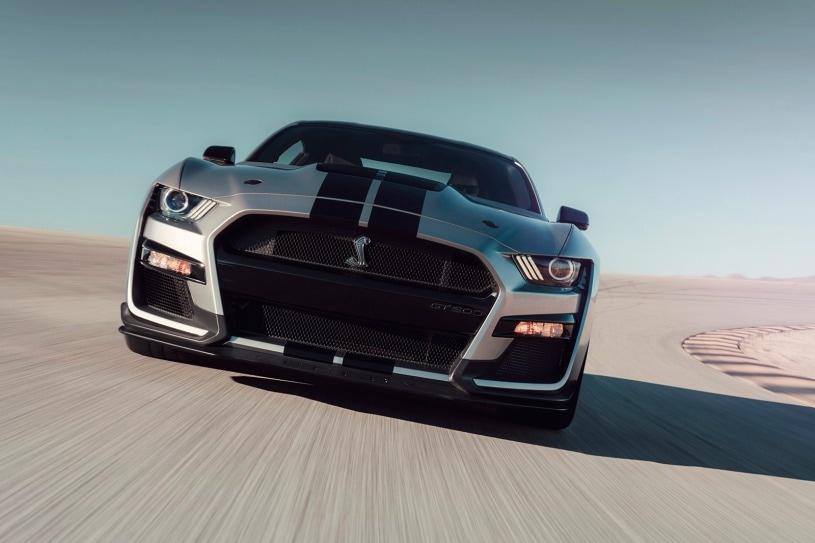
Keep Your Cool
Form and function are so tightly tied together in the GT500 that when we do finally get around to talking about the car's appearance, we're also talking about its cooling and aero. The giant front grille, slotted hood and ground-level winglets are all designed to keep the engine cool and the car pressed firmly to the ground at speed. Cooling airflow in the GT500 is double that of the GT350. The fenders are wider in the front to accommodate 20-by-11-inch wheels, and a rear wing and diffuser are standard to make sure air is managed all the way along its journey.
Downforce and power can't do much without good rubber on the wheels, so the GT500 wears Ford Performance-spec Michelin Pilot Sport 4S tires that are backed by 16.5-inch brake rotors and Brembo six-piston calipers. If you're having trouble visualizing that, imagine a large pizza — only it's made of a brake disc.
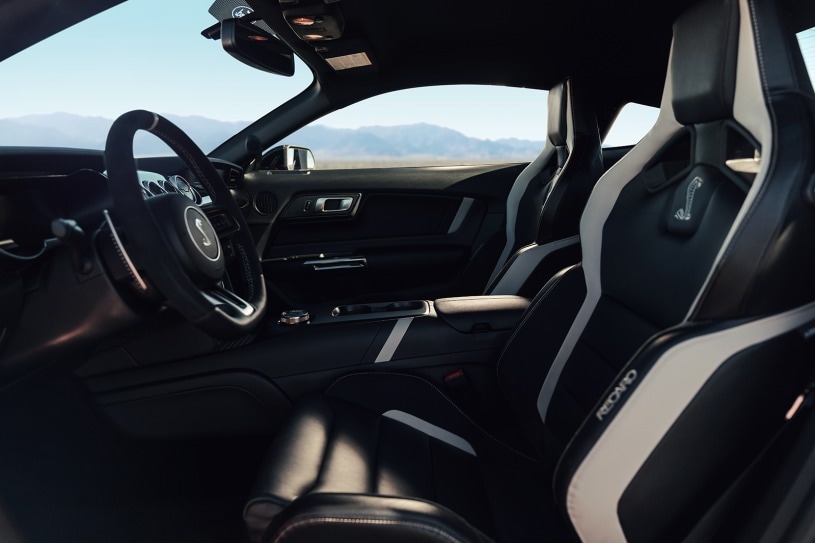
Snake Eyes
From the driver's seat, you're probably going to be hypnotized by the long hood and racy air-extractors. But if you spare a moment for the interior, you can admire an optional exposed carbon-fiber instrument panel design, suede door panel inserts and a 12-inch LCD instrument cluster. If the supercharged V8's rumble isn't your kind of music, a 12-speaker Bang & Olufsen audio system is available. A Sync 3 touchscreen supports Apple CarPlay and Android Auto if you get lost on the way to the track. And just in case you forget that you're in a Shelby, the striking-cobra logo that adorns the front grille, both fenders and the rear tail panel is repeated on the seatbacks, steering wheel and infotainment screen. We counted 11 snakes in all, but there might still be some hiding in there.
Upgrade Me
If for some reason the base GT500 isn't enough, there are two upgrades available. The Handling package adds adjustable strut mounts for increased rigidity and a rear spoiler with a Gurney flap. To go all in, opt for the Carbon Fiber Track pack. It deletes the rear seat, bolts on 20-inch carbon-fiber wheels (widened in the back to 11.5 inches) with Michelin Pilot Sport Cup 2 rubber, and adds the carbon-fiber rear wing from the GT4 Mustang racing program. An upgraded front splitter extends up the sides of the wheelwells for increased downforce.
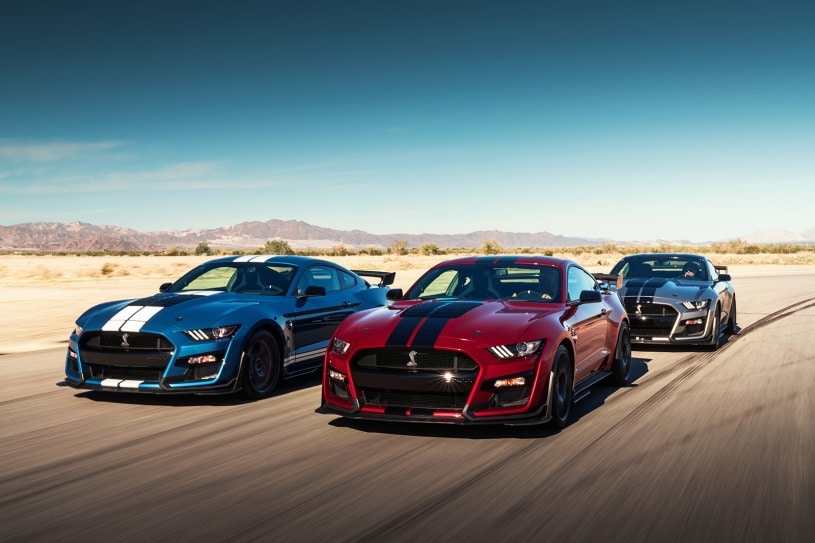
Pricing and Release Date
The Ford Shelby GT500 has a serious legacy to live up to, as well as some serious competition. American rivals include hopped-up Camaros and Challengers, while European marques such as Porsche and BMW offer different takes on ultra-high-performance motoring. Ford seems confident that the new GT500 won't disappoint, and our first look has us excited to see more. Horsepower announcements are coming soon, and pricing will be available in fall 2019. We expect the car to hit showrooms shortly thereafter.
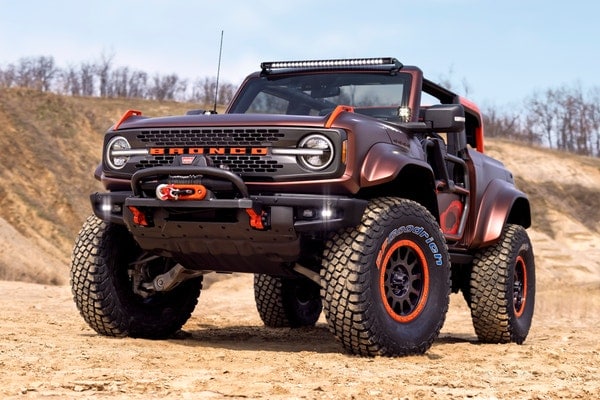


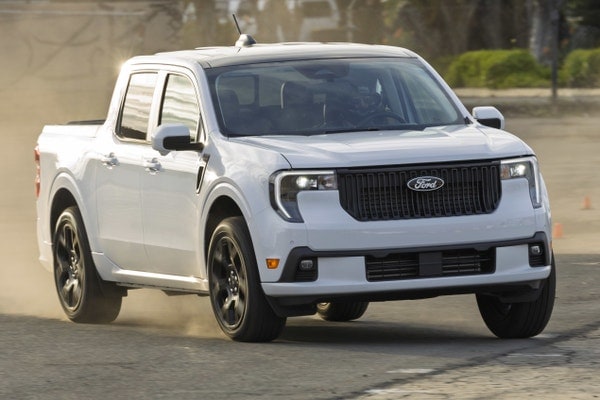
Cost to DriveCost to drive estimates for the 2020 Ford Shelby GT500 2dr Coupe (5.2L 8cyl S/C 7AM) and comparison vehicles are based on 15,000 miles per year (with a mix of 55% city and 45% highway driving) and energy estimates of $3.99 per gallon for premium unleaded in Connecticut.
See Edmunds pricing data
Has Your Car's Value Changed?
Used car values are constantly changing. Edmunds lets you track your vehicle's value over time so you can decide when to sell or trade in.

Ford Shelby GT500 Reviews
Owner Reviews
Most Helpful Owner Reviews
Trending topics
Sweet
5 out of 5 starsSnake bit
5 out of 5 stars2020 Ford Shelby GT500 videos
These Are the Best-Performing Cars We’ve Ever Tested | 0-60, Quarter Mile, Handling & More
- These Are the Best-Performing Cars We’ve Ever Tested | 0-60,...
- Every Race We Did in Our Ford Mustang Shelby GT500 | Mustang...
- 28,000 Miles in the Ford Mustang Shelby GT500 | Living with ...
- U-DRAG: Shelby GT500 vs. Dodge Challenger Black Ghost
- U-DRAG: BMW M8 Competition vs. Shelby GT500
- U-DRAG: 2023 Corvette Z06 vs. 2020 Shelby GT500
- Drag Race! Ford Mustang Shelby GT500 vs. Cadillac CT5-V Blac...
- Drag Race! Ford Mustang Mach-E vs Shelby GT500 | Which Musta...
- Drag Race! Shelby GT500 vs. Mustang Mach 1 | Which Mustang I...
- Drag Race! Ford Shelby Mustang GT500 vs. BMW M4 Competition ...
- Drag Race! Tesla Model Y vs. Shelby GT500 | EV vs. Muscle | ...
- Drag Race! BMW M8 vs. Ford Shelby GT500 — Sport Coupe Drag R...
- Drag Race! Porsche 911 vs. Chevy Corvette vs. Shelby GT500 —...
- Porsche 911 vs. Shelby GT500 vs. Chevy Corvette ― Sports Car...
- 2020 Shelby GT500 Long-Term Update! How Fast Is It? Ultimate...
- Best Muscle Cars — Chevy Camaro, Dodge Challenger and Ford M...
- We Bought a 2020 Ford Mustang Shelby GT500! Unboxing, Overvi...
- Muscle Car Debrief: Ford Mustang Shelby GT500 vs Dodge Chall...
- Ford Mustang Shelby GT500 vs. Dodge Challenger Hellcat vs. C...
- Ford Mustang Shelby GT500 vs. Dodge Challenger Hellcat Redey...
- 2020 Ford Mustang Shelby GT500 Review — Test Drive of the Mo...
- 2020 Ford Mustang Shelby GT500 First Look and Details | Edmu...
2020 Shelby GT500 Highlights
| Base MSRP Excludes Destination Fee | $70,300 |
|---|---|
| Engine Type | Gas |
| Combined MPG | 14 MPG |
| Cost to Drive | $339/month |
| Seating | 4 seats |
| Cargo Capacity All Seats In Place | 13.5 cu.ft. |
| Drivetrain | rear wheel drive |
| Warranty | 3 years / 36,000 miles |
Safety
Our experts like the Shelby GT500 models:
- SOS Post-Crash Alert System
- Sounds the horn and flashes the emergency indicators in the event of a crash, alerting emergency workers of your location.
- Rearview Camera
- Helps you navigate into tight parking spots and avoid collisions when backing out of spots in crowded parking lots.
- Ford MyKey
- Allows the owner to set secondary-driver parameters and limits for teen and valet drivers.
Related Used 2020 Ford Shelby GT500 info
Vehicle reviews of used models
- Jaguar F Type 2020 Review
- GMC Yukon XL 2021 Review
- Ram 1500 Classic 2021 Review
- Nissan Sentra 2021 Review
- Audi SQ7 2021 Review
Popular new car reviews and ratings
- 2026 Hyundai Santa Cruz News
- 2024 Mercedes-Benz AMG GT
- New BMW 4 Series
- Cadillac Escalade ESV 2024
- 2025 Ford E-Transit Cargo Van
- 2026 Subaru Impreza News
- New BMW 2 Series Gran Coupe
- 2026 Ford Maverick News
- New Volvo V60 Cross Country
- 2026 Audi A3 News
Research other models of Ford
- 2025 Ford Explorer
- Ford F-150 2025
- Ford Mustang 2025
- New Ford Escape
- 2025 Ford Mustang Mach-E
- 2025 F-250 Super Duty
- New Ford Ranger
- 2025 Ford Ranger
- 2025 Ford Escape
- 2025 Ford Maverick
Other models
- Used Mazda 6 in Lockport, IL 2021
- Used Oldsmobile Eighty-Eight in Georgetown, TX 1999
- Used BMW 4-Series in Irving, TX 2025
- Used Nissan 370Z in Fort Collins, CO 2020
- Used Mitsubishi Raider in Shepherdsville, KY 2009
- Used Mazda CX-50 in Clementon, NJ 2025
- New Dodge Hornet for Sale in Youngstown, OH
- Used Oldsmobile Silhouette in Lenoir City, TN 2004
- Used Volkswagen Jetta-Sportwagen in Hayward, CA 2014
- New Genesis G90 for Sale in Ardmore, OK